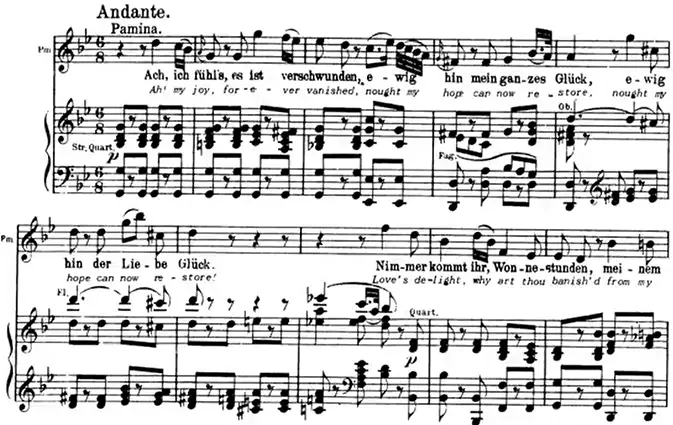ACH, ICH FÜHL’S – an aria from the opera die Zauberflöte (Magic Flute)
The Portrait of Mozart’s Aria ACH, ICH FÜHL’S
Read Interesting facts and hear great YouTube Videos about the famous Aria “ACH, ICH FÜHL’S”.
If you want to hear more about the opera THE MAGIC FLUTE , click on the link to the opera portrait
The aria – synopsis and background
Synopsis: Tamino and Papageno must pass trials to be received into the circle of initiates. Only then will Tamino be able to marry Pamina. During his trial Tamino gets his flute back. Pleased he plays the instrument and Pamina appears, attracted by the sound. When she speaks to him, Tamino remains silent and Pamina thinks she has lost Tamino’s love. She doesn’t know that Tamino’s silence is part of the test.
This aria is written in a deeply sad G minor tune. Pamina must be able to draw long piano lines and form beautiful phrases. Every vocal must be sung out.
The orchestra begins in a slow andante with a rhythm similar to a funeral march. The appogiaturas notes on “fühls” and “hin” in the first verse give the piece an infinitely painful character that contrasts with the warm high B flat on “Liebe” of the second verse. This is followed by a wonderfully nostalgic “Nimmer kommet ihr, Wonnestunden” (Never will you, hours of delight):
Next we hear a coloratura chain as we know it from her mother, the queen of the night. But the coloraturas ares not garish and loud, but lyrical and quiet:
One difficulty is to sing this coloraturas with a perfect legato, without taking breath, because the word heart (the only text of this long coloratura) should not be interrupted. This leads to the question of the tempo at which the aria should be sung, which we will discuss further below in the section of YouTube videos.
In the next passage Tamina asks Tamino in disbelief “don’t you feel the longing for love? (don’t you feel the longing of my love) and at the word “love” the high B only sounds sad and resigned. In the passage “so wird Ruh im Tode sein” (oh return or let me die) the music becomes ghostly and pale. The ethereal pianissimo leaps already seem to sound from the hereafter:
The Aria – the text of ACH, ICH FÜHL’S
Ach ich fühls, es ist verschwunden –
Ewig hin der Liebe Glück!
Nimmer kommt ihr, Wonnestunden,
Meinem Herzen mehr zurück.
Sieh Tamino, diese Thränen
Fliessen Trauter, dir allein.
Fühlst du nicht der Liebe Sehnen,
So wird Ruh im Tode seyn.
Ah, I can feel it, love’s happinessIs fled forever!Nevermore, O hours of bliss,Will you return to my heart!See, Tamino, these tearsFlow for you alone, beloved.If you do not feel love’s yearning,I shall find peace in death!
Written for a “lyrical soprano”
The role of Pamina is written for a lyrical soprano. The lyrical soprano must have a voice with a warm timbre and must be able to convince with a bell-like sound in the high register. This should be colourful and must not sound forced. The middle register must be rich.
Famous interpretations of ACH, ICH FÜHL’S
Mozart wrote practically no instructions in the score of the singing voice, so that the singer has considerable room for interpretation. In addition, opinions differ widely as to how quickly this aria should be sung. The duration of Diana Damrau’s aria, for example, is 4:31, much longer than that of Barbara Bonney’s 3:34, or Renee Fleming’s 3:01.
Barbara Bonney’s interpretation is breathtaking. It is very lyrical despite the fast tempo.
Ach, ich fühls (1) – Bonney
We hear beautiful high pianissimo notes (like Caballé !) from Anna Moffo.
Ach, ich fühls (2) – Moffo
Tiana Lemnitz (called “Piano Lemnitz”) was famous for her piano. Her Pamina of the highly praised Beecham-recording from 1937 is considered one of the reference recordings of the Pamina.
Ach, ich fühls (3) – Lemnitz
A highly exciting master class by Elisabeth Schwarzkopf on how to sing Mozart.
Ach, ich fühls (4) – Masterclass Schwarzkopf
And now a Schwarzkopf Interpretation with a shining Pamina.
Ach, ich fühls (5) – Schwarzkopf
Renée Fleming’s interpretation shows more despair than resignation. The coloraturas in particular show an shiver.
Ach, ich fühls (6) – Fleming
The slow tempo gives the interpretation of Diana Damraus a resignative mood.
Ach, ich fühls (7) – Damrau
Peter Lutz, opera-inside, the online opera guide to the Aria “ACH, ICH FÜHL’S” from the opera Die Zauberflöte.







Leave a Reply
Want to join the discussion?Feel free to contribute!